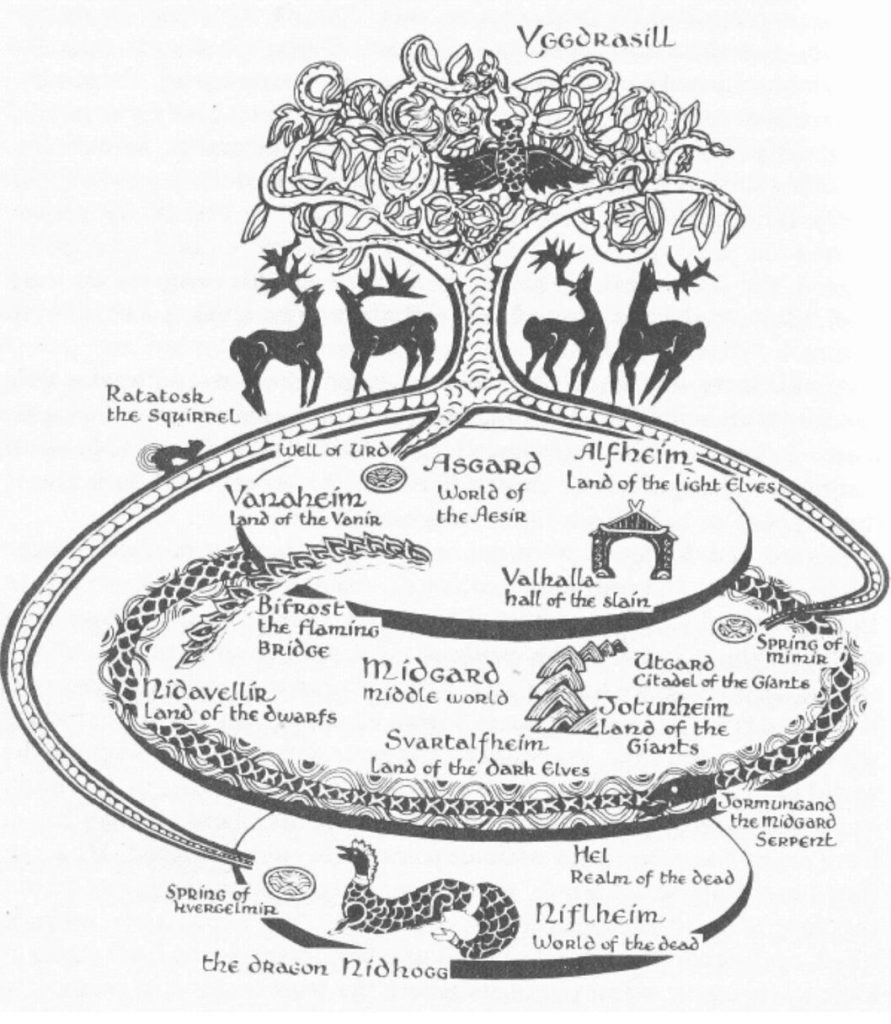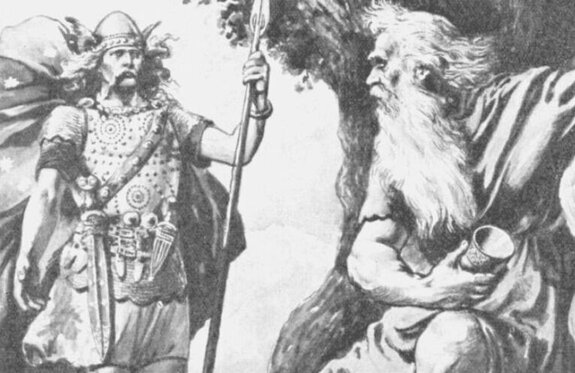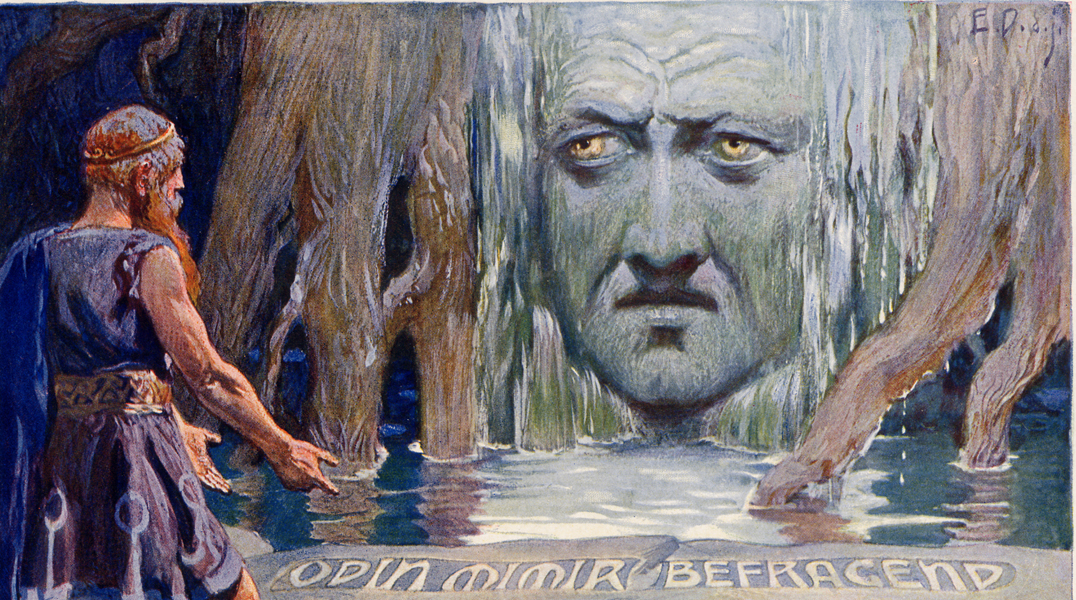In Norse mythology, Mimir is considered the wisest of the gods of Asgard. Mimir is the guardian of the well of wisdom called Mimisbrunnr in Old Norse.
The name Mimir means the rememberer and is sometimes shortened to Mim. Mimir is also believed to come from the Indo-European root word for memory.
Mimir’s well is said to store the wisdom and knowledge of the world. The well is beneath the roots of Yggdrasil (the World Tree), located in the realm of giants.
Anyone who drinks water from Mimir’s well gains knowledge and wisdom beyond anything they are capable of on their own. Many gods sought out Mimir for advice. According to the accounts in both the Poetic Edda and the Prose Edda, Odin was a common visitor to Mimisbrunnr, seeking council from the wise Mimir.
The story of Mimir is also retold in the Ynglinga Saga. This story is contained in another work by Icelandic historian Snorri Sturluson called the Heimskringla.
What is Mimir considered to be the god of?
Mimir is referred to as the Norse god of wisdom. He is considered a valuable member of the Æsir tribe and Odin’s closest confidant.
Mimir is also thought to be a water spirit. Guarding the well of wisdom required Mimir’s full attention. He is said to have lived beside the well, beneath Yggdrasil.
In honor of Mimir’s devotion to guarding the well, Yggdrasil is often called Mimameidr. Mimameidr is Old Norse and translates to Mimir’s tree.
The Norse gods often called upon Mimir to settle disputes and give advice. While Odin was a frequent visitor, Hoenir was also known to seek out Mimir’s wisdom. Hoenir became so dependent on Mimir that he wouldn’t answer without asking Mimir first.

Is Odin or Mimir the wiser Norse god?
Mimir was wiser than the Norse god of war, Odin.
Odin often sought council from Mimir, deferring to Mimir in matters of great importance. When Odin asked Mimir to allow him to drink from the well, Mimir placed the condition that Odin would first have to sacrifice his eye.
Odin’s wish for more knowledge was so strong that he plucked his own eye out and placed it in Mimir’s well.
While this might seem drastic, sacrifice for desired attributes was common among the Norse gods. Once the eye was removed, Odin was allowed to drink from the well of wisdom.
Odin used the horn Gjallarhorn to drink from the well. This is the same horn Heimdall would later blow to announce the beginning of Ragnarök.
The water bestowed Odin with great knowledge. Quenched by the magical water, Odin was far wiser than before but still second to Mimir.
After sacrificing his eye, Odin was known as the one-eyed Allfather.
Are Mimir and Odin related to each other?
Like many of the Norse gods, Mimir and Odin are related. Mimir is the son of Bolthorn, making Mimir the brother of Bestla. Since Bestla is Odin’s mother, Mimir is Odin’s maternal uncle.
In the stories recounting their interactions, Odin refers to Mimir as “uncle,” attempting to use their relationship to coax Mimir to allow him to drink from the well.
Despite being related, Mimir insists that Odin sacrifice his eye for a drink, which Odin does without hesitation.

Mimir’s Decapitation
The Vanir gods decapitated Mimir during the Æsir-Vanir war.
It was a common practice to send hostages to warring tribes, and it was considered an honor to be chosen. Mimir was one of two hostages sent by the Æsir. The Vanir sent Freyr, Njord, and Freyja.
The second hostage sent from the Æsir was Hoenir (Hœnir). Upon arrival, Hoenir was made chief of Vanaheim.
When it became clear the Hoenir was useless without the council of the wise Mimir, the Vanir gods decapitated Mimir. The Vanir left Mimir’s body to rot in the woods and sent his head to Odin.
What did Odin do with Mimir’s head?
Odin used herbs for embalming Mimir’s severed head. Using magical chants, Odin was able to revive Mimir’s head. Odin consulted the head often, which he laid beneath Yggdrasil for safe keeping when he wasn’t carrying Mimir with him. Odin is said to have carried the severed head for years.
It wasn’t long after Mimir’s head was severed that Norse gods grew tired of warring. They ended the Æsir-Vanir war, seeking a truce. Mimir is credited with arbitrating the truce despite the Vanir being responsible for his bodiless life.
To reward Odin for reviving his head, Mimir taught Odin the secret of the runes. This ancient written language of Scandinavia was a gift likened to giving Odin magical powers. Once Odin learned the secret of the runes, he added the ‘god of runes’ to his many names.
Mimir’s Legacy
While you might wonder why Odin, the god of war, would be foolish enough to trade Mimir to his enemies, the origins of hostage exchange are firmly rooted in Viking and Germanic cultures.
Sending delegates from one tribe to be held by a rival tribe ensured treaties were honored. Both tribes had something to lose, so hostages were often people of the highest value.
Unfortunately for Mimir, the outcome wasn’t great. But despite losing his head, Mimir continued to bring value and share his wisdom with Odin.

